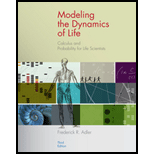
Concept explainers
(a)
To find: The derivatives of the given function, the critical points, and the point of infection. Also, determine the situation when more and more cosines are piled up and explain it in terms of the updating function
(a)
Answer to Problem 43E
The derivate is
Explanation of Solution
Given:
The expression is
Calculation:
The critical point is the point on the curve where the slope of the tangent is zero and the tangent is parallel to the x axis.
The point of inflexion is the point on the curve at which the sign of the curvature changes.
Consider the given expression is,
Differentiate the above equation with respect to
The graph for the above function is shown in Figure 1
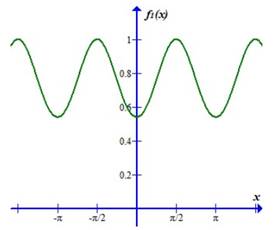
Figure 1
Then, the critical points are
The point of inflexion is
The critical points are
From the above calculations it is observed that as more and more cosines are piled up the graph of the function is flat and stable at one value.
(b)
To find: The derivatives of the given function, the critical points, and the point of infection. Also, determine the situation when more and more cosines are piled up and explain it in terms of the updating function
(b)
Answer to Problem 43E
The derivate is
Explanation of Solution
Given:
The expression is
Calculation:
The critical point is the point on the curve where the slope of the tangent is zero and the tangent is parallel to the x axis.
The point of inflexion is the point on the curve at which the sign of the curvature changes.
Consider the given expression is,
Differentiate the above equation with respect to
The graph for the above function is shown in Figure 1
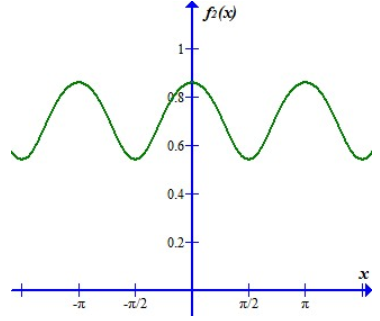
Figure 1
Then, the critical points are
The point of inflexion is
The critical points are
From the above calculations it is observed that as more and more cosines are piled up the graph of the function is flat and stable at one value.
(c)
To find: The derivatives of the given function, the critical points, and the point of infection. Also, determine the situation when more and more cosines are piled up and explain it in terms of the updating function
(c)
Answer to Problem 43E
The derivate is
Explanation of Solution
Given:
The expression is
Calculation:
The critical point is the point on the curve where the slope of the tangent is zero and the tangent is parallel to the x axis.
The point of inflexion is the point on the curve at which the sign of the curvature changes.
Consider the given expression is,
Differentiate the above equation with respect to
The graph for the above function is shown in Figure 1
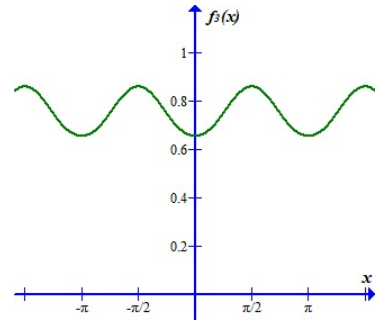
Figure 1
Then, the critical points are
The point of inflexion is
The critical points are
From the above calculations it is observed that as more and more cosines are piled up the graph of the function is flat and stable at one value.
(d)
To find: The derivatives of the given function, the critical points, and the point of infection. Also, determine the situation when more and more cosines are piled up and explain it in terms of the updating function
(d)
Answer to Problem 43E
The derivate is
Explanation of Solution
Given:
The expression is
Calculation:
The critical point is the point on the curve where the slope of the tangent is zero and the tangent is parallel to the x axis.
The point of inflexion is the point on the curve at which the sign of the curvature changes.
Consider the given expression is,
Differentiate the above equation with respect to
The graph for the above function is shown in Figure 1
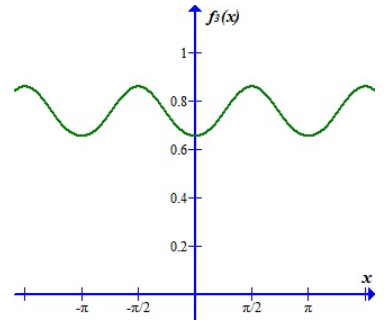
Figure 1
Then, the critical points are
The point of inflexion is
The critical points are
From the above calculations it is observed that as more and more cosines are piled up the graph of the function is flat and stable at one value.
Want to see more full solutions like this?
Chapter 2 Solutions
Modeling the Dynamics of Life: Calculus and Probability for Life Scientists
- Problems Construct shear and moment diagrams using the equilib- rium method. Indicate the magnitudes of Vmax and Mmax. 7.3 107 B 5' 201arrow_forwardCan you help me with this problem using linear recurrance: Find an explicit formula for the recurrence relation an = 2can−1 + 3c2an−2 where c not equal to 0 with initial conditions a0=4c and a1 = 0arrow_forwardCan you help me solved this problem using generalized combination:How many combinations are there to pick r objects from 2n objects numbered from 1to 2n when repetitions are allowed and at least one object of odd type does not appear?arrow_forward
- In Exercises 1-14, state whether each statement is true or false. If false, give a reason. 1. The set of stores located in the state of Wyoming is a well- defined set. 2. The set of the three best songs is a well-defined set. 3. maple = {oak, elm, maple, sycamore} 4{} cơ 5. {3, 6, 9, 12,...} and {2, 4, 6, 8, ...} are disjoint sets. 6. {Mercury, Venus, Earth, Mars} is an example of a set in roster form. 7. {candle, picture, lamp} = {picture, chair, lamp } 8. {apple, orange, banana, pear} is equivalent to {tomato, corn, spinach, radish}.arrow_forwardExercises Evaluate the following limits. 1. lim cot x/ln x +01x 2. lim x² In x +014 3. lim x* x0+ 4. lim (cos√√x)1/x +014 5. lim x2/(1-cos x) x10 6. lim e*/* 818 7. lim (secx - tan x) x-x/2- 8. lim [1+(3/x)]* x→∞0arrow_forwardIn Exercises 1 through 3, let xo = O and calculate P7(x) and R7(x). 1. f(x)=sin x, x in R. 2. f(x) = cos x, x in R. 3. f(x) = In(1+x), x≥0. 4. In Exercises 1, 2, and 3, for |x| 1, calculate a value of n such that P(x) approximates f(x) to within 10-6. 5. Let (an)neN be a sequence of positive real numbers such that L = lim (an+1/an) exists in R. If L < 1, show that an → 0. [Hint: Let 1111 Larrow_forwardiation 7. Let f be continuous on [a, b] and differentiable on (a, b). If lim f'(x) xia exists in R, show that f is differentiable at a and f'(a) = lim f'(x). A similar result holds for b. x-a 8. In reference to Corollary 5.4, give an example of a uniformly continuous function on [0, 1] that is differentiable on (0, 1] but whose derivative is not bounded there. 9. Recall that a fixed point of a function f is a point c such that f(c) = c. (a) Show that if f is differentiable on R and f'(x)| x if x 1 and hence In(1+x) 0. 12. For 0 л/2. (Thus, as x л/2 from the left, cos x is never large enough for x+cosx to be greater than л/2 and cot x is never small enough for x + cot x to be less than x/2.)arrow_forward1. Show that f(x) = x3 is not uniformly continuous on R. 2. Show that f(x) = 1/(x-2) is not uniformly continuous on (2,00). 3. Show that f(x)=sin(1/x) is not uniformly continuous on (0,л/2]. 4. Show that f(x) = mx + b is uniformly continuous on R. 5. Show that f(x) = 1/x2 is uniformly continuous on [1, 00), but not on (0, 1]. 6. Show that if f is uniformly continuous on [a, b] and uniformly continuous on D (where D is either [b, c] or [b, 00)), then f is uniformly continuous on [a, b]U D. 7. Show that f(x)=√x is uniformly continuous on [1, 00). Use Exercise 6 to conclude that f is uniformly continuous on [0, ∞). 8. Show that if D is bounded and f is uniformly continuous on D, then fis bounded on D. 9. Let f and g be uniformly continuous on D. Show that f+g is uniformly continuous on D. Show, by example, that fg need not be uniformly con- tinuous on D. 10. Complete the proof of Theorem 4.7. 11. Give an example of a continuous function on Q that cannot be continuously extended to R. 12.…arrow_forwardcan I see the steps for how you got the same answers already provided for μ1->μ4. this is a homework that provide you answers for question after attempting it three triesarrow_forwardarrow_back_iosSEE MORE QUESTIONSarrow_forward_ios
- Algebra & Trigonometry with Analytic GeometryAlgebraISBN:9781133382119Author:SwokowskiPublisher:Cengage


